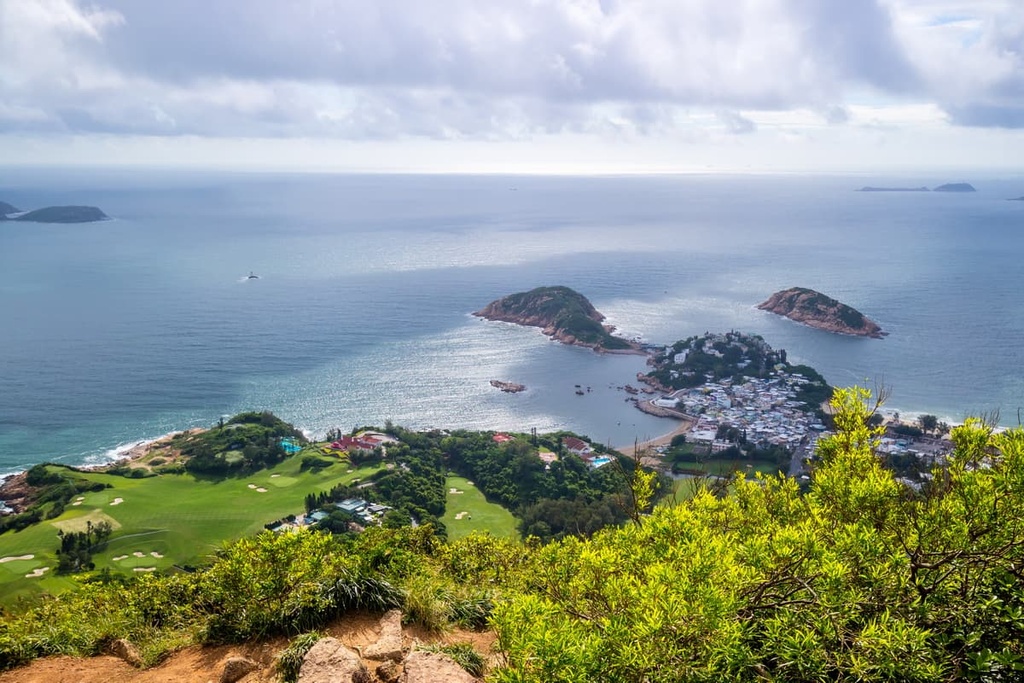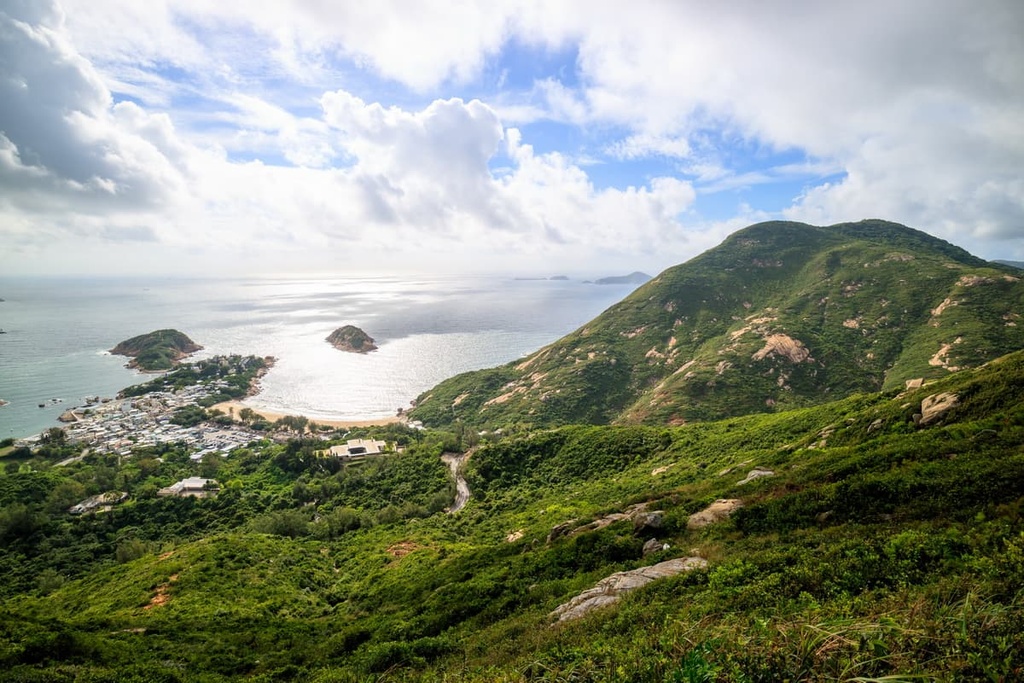Get PeakVisor App
Sign In
Search by GPS coordinates
- Latitude
- ° ' ''
- Longitude
- ° ' ''
- Units of Length

Yes
Cancel
Share ×

Scan the QR code and open PeakVisor on your phone
❤ Wishlist ×
Choose
Delete
Tucked away in the Hong Kong Special Administrative Region of China, Shek O Country Park offers some of the best urban hiking in the world. This park has 7 named peaks, the highest of which is Mount Collinson (348 m/1,142 ft) and the most prominent of which is D’Aguilar Peak (326 m/1,070 ft).

Shek O Country Park occupies an area of 701 hectares (1,732 acres) in the southeastern corner of Hong Kong Island on the Shek O Peninsula, which forms the “hind leg” of the frog-shaped island. It takes up most of the peninsula except for some stretches on the coast.
Beaches, villages, a country club, and disused military installations border the park on the peninsula. On the inland side, the district of Chai Wan lies to the north of the park, while Tai Tam Country Park is situated across Tai Tam Road on the northwestern corner of the peninsula.
Inside the park, a ridgeline connecting Pottinger Peak (312 m/ 1,024 ft) and Mount Collinson (348 m/ 1,076 ft) sprawls across the northern side. In the middle, another ridgeline known as Dragon’s Back links Wan Cham Shan (265 m/ 869 ft) with Shek O Peak (284m/ 932 ft). On the southern end of the park is its most prominent point, D'Aguilar Peak (326m/ 1,070 ft).
The park is a catchment area of the Tai Tam Group of Reservoirs in the neighboring Tai Tam Country Park. Many kilometers of waterworks facilities known as catchwaters divert some of the natural streams in Shek O to these reservoirs.

The area is predominantly made up of granite that formed about 140 million years ago, a period that marked the final episode of Hong Kong’s volcanic activity. During that episode, a volcano developed in the area of Rocky Harbour in western Hong Kong.
A cataclysmic explosion resulted in the collapse of the caldera and the accumulation of a huge volume of ash in the volcanic depression. Over time, the ash lithified into different types of igneous rocks, such as the granite and quartz monzonite, in the area that is now Shek O.
Quartz monzonite, which is found on and around D'Aguilar Peak, is similar to granite but only contains 5 to 20 percent quartz while granite contains about 20 to 60 percent quartz. It is not as hard as granite because of its lower quartz content.
The granite in Shek O and elsewhere in the city shows little signs of erosion like large joints, making it a high-quality building material. On the west coast of the Shek O Peninsula, the Shek O Quarry mined the region’s granite from 1965 to 2009. The site has since been restored and designated as a water sports center.
Rocks exposed to seawater in the park, on the other hand, display a variety of features caused by wave erosion, such as sea caves, cliffs and wave-cut platforms. Meanwhile, wave deposition in sheltered coastal areas produced the famous beaches of Shek O.

Like most other country parks in the city, Shek O Country Park lost much of its vegetation cover during World War II when the Japanese invaders indiscriminately cleared it for fuel. The lush landscape today is a result of painstaking reforestation efforts.
The most common trees in the park are Hong Kong gordonia (Polyspora axillaris), rose myrtle (Rhodomyrtus tomentosa), aporusa (Aporusa dioica) and ivy tree (Schefflera heptaphylla).
The park is also home to rare tree species such as Buddhist pine (Podocarpus macrophyllus). Apart from its ornamental value, this slow growing native species is considered to be a “feng shui tree” and it’s believed to bring good fortune. It used to be a prime target for illegal harvesting that caused a rapid decline in its numbers.
The abundance of plants in Shek O supports a fair number of bird species like common buzzard, barn swallow, little swift,and Chinese francolin. The seaside location also attracts species such as white-bellied sea eagle.
The forested areas in the park shelter mammals typical to Hong Kong’s countryside. Commonly found species include masked palm civet, small Indian civet, Chinese ferret badger, red muntjac, and Chinese porcupine.

The catchwaters and natural streams are ideal habitat for dragonflies and damselflies, whose presence is an indicator of good water quality. These insects are closely related but it’s easy to tell them apart as dragonflies hold out their wings when resting while damselflies fold theirs up.
The area that is now Shek O Country Park has been inhabited for over 200 years, with several villages scattered along the coast. The villagers traditionally made a living by fishing and farming, though some moved uphill in times when pirates were particularly abundant.
The biggest of the villages, Shek O Village, had 150 residents in 1841 when the first official census was conducted. It was a sizable Indigenous community at a time when the population of Hong Kong Island was just about 7,500 people.
While most Indigenous villages in Hong Kong were made up of a single ethnic group with the same family name, those in Shek O were a mixture of ethnic groups and clans. Nevertheless, Shek O has always been a close-knit community.
The villagers on Shek O used to bury the deceased on the hills in places where the feng shui was good. You can still see some ancestral graves that are more than a century old in the park.
One of the oldest buildings in Shek O is the Tin Hau Temple, which is dedicated to the goddess of the sea. The well-preserved temple in the heart of the present Shek O Village was completed by the late nineteenth century.
In the 1920s, the colonial government granted tracts of land in Shek O to British merchants for building exclusive recreational facilities for the British and Americans. As part of the Shek O peninsula became a playground for wealthy foreigners, many villagers were dispossessed of their properties or shortchanged.
The Shek O Country Club, for example, was built on the original Shek O Village and the locals were forced to move down the coast to rebuild their village. Meanwhile, foreigners lured by the pleasant environment began to settle next to the villagers, turning the area into an upscale residential neighborhood.

In more recent years, both the foreign residents and Indigenous communities have lived surprisingly well side-by-side in Shek O. In fact, Shek O is now known for being a proudly eclectic community with a strong sense of identity and solidarity.
Once every ten years, the local and foreign residents of Shek O celebrate the Tai Ping Ching Chiu Festival (太平清醮), a tradition that has lasted for more than two centuries. The origin was to solicit protection from divine powers and appease homeless souls. It features five days of fasting, ceremonies, Chinese opera performances and an iconic “floating colors” parade (飄色).

The hiking trails in Shek O Country Park are short and beginner level, but the views are hard to beat. They are popular with locals, expatriates and tourists alike. Here is an overview of the best routes.
Resembling the undulating spine of a dragon, the Dragon’s Back Trail was named Asia’s best urban hike by Time Magazine. From the trailhead at To Tei Wan, a mere 20-minute walk takes hikers to a stunning viewpoint, but that is just the beginning of the adventure.
The 8-km (5-mi) trail, which is the last section of the 50-km (31-mi) Hong Kong Trail, overlooks lovely beaches, the rolling greens of Shek O Country Club, Tai Tam Bay, and the South China Sea. After cresting the highest point on Shek O Peak, the trail leads to its end point at the beach in Big Wave Bay.
This 8-km (5-mi) route along Tai Tam Road largely follows the western border of the park along a catchwater. It is mostly flat or downhill, overlooking Tai Tam Bay and passing through old fishing villages.

At Lan Nai Wan Village, the idyllic Taoist temple of Lin Hok Sin Koon (蓮鶴仙觀) is located just off the trail. This stretch is the seventh and penultimate section of the Hong Kong Trail, and it connects with the last section that leads to Dragon’s Back.
Located on the doorsteps of the urban area with a length of just 1.9 km (1.2 mi), the Pottinger Peak Country Trail provides a quick, convenient and very scenic hiking fix. It offers commanding views of the hectic cityscape of Chai Wan to the north, the open seascape of Big Wave Bay to the east, and the verdant hills of the park to the southwest.
It is well worth taking short detours to the Pottinger Peak Lookout and the Pottinger Peak View Compass along this trail. Close to the eastern end of the trail, a path also branches off to the south toward the beach at Big Wave Bay.

The seaside community of Shek O is a popular tourist attraction that’s famous for its laid-back vibe. It is a prime location for having barbecues on the beach and paragliding over the coast. Shek O Beach is a favorite among the locals with its fine sand, good water quality and excellent facilities.
Shek O is a quaint community with simple village houses on the beachfront and luxury mansions just up the road. Some of the homes are colorfully painted in pastel hues, which is quite unique and exotic in Hong Kong. The distinct absence of tall buildings and shopping malls also make it a refreshing getaway for city dwellers.
Explore Shek O Country Park with the PeakVisor 3D Map and identify its summits.








